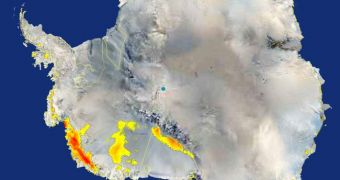90 % of the ice on Earth is stored in Antarctica, being the Earth's largest amount of freshwater.
You can imagine that minimal changes in the ice mass of Antarctica have a deep impact on raising the global sea level. Large quantities of Antarctic molten freshwater shed into the ocean could have a deep impact in the ocean salinity, currents and global climate.
Now researchers inform that warm temperatures melted an ice chunk of western Antarctica estimated to have been the size of California in January 2005. The results are based on satellite data gathered by researchers between July 1999 and July 2005 revealing clearly how melting had taken place in various distinct regions, including far inland and at high latitudes and elevations, where melt was supposed to be unlikely.
"Antarctica has shown little to no warming in the recent past with the exception of the Antarctic Peninsula. But now large regions are showing the first signs of the impacts of warming as interpreted by this satellite analysis." said Konrad Steffen of the University of Colorado, Boulder.
NASA's QuikScat satellite tracked down snowmelt by using radar pulses that bounce off of ice that formed when snowmelt refroze (like icecream transformed into ice when refrozen).
Maximum positive temperatures of 41 degrees Fahrenheit (+5 degrees C) lasting for about a week in Antarctica induced a massive melt enough to create after that an extensive ice layer. Melting proofs were detected 560 miles (900 km) inland from the sea shore, farther than 85 degrees south (at just 310 miles (500 km) from the South Pole) and at altitudes higher than 6,600 feet (2,000 m) above the sea level.
"Water from the melted snow can penetrate cracks and the ice, lubricating the continent's ice sheets, sending them toward the ocean faster and raising sea levels," warned the researchers.
"Increases in snowmelt, such as this in 2005, definitely could have an impact on larger scale melting of Antarctica's ice sheets if they were severe or sustained over time," Steffen said.

 14 DAY TRIAL //
14 DAY TRIAL //